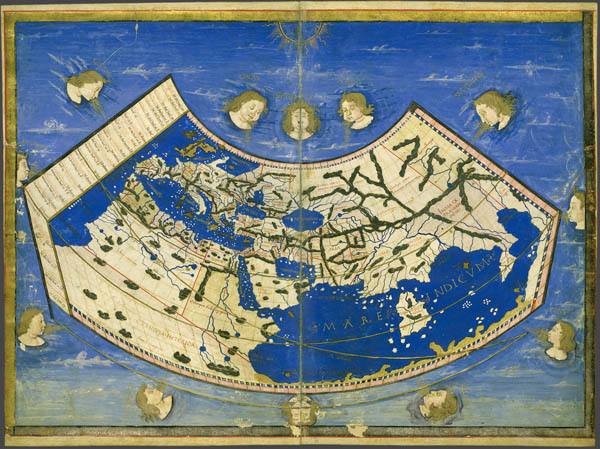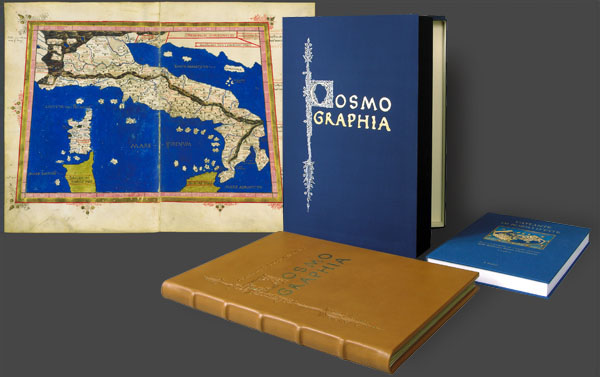  

  
Illuminated manuscript
cm 31x45,
1466
ISBN 88-86251-53-x
Price: € 5.900,00
|
|
ATLAS OF BORSO D'ESTE
Ptolemy's Cosmography

Ptolemy’s Cosmography is a milestone of Humanism, of its thirst for knowledge: a precursor to the Renaissance ideals and to the age of the great geographical discoveries.
The first universal atlas
The Ptolemaic tradition, codified in Greek manuscripts, was rediscovered in the 15th century when in Florence, an intellectual and artistic capital, the scientific and cartographic research, which marked the age of great geographical discoveries, was developed. Florentine workshops compiled and illuminated the most beautiful copies ever realized of Ptolemy’s treatises.
The most powerful rulers of the Renaissance – Borso, Federico da Montefeltro, Matthias Corvino of Hungary, Louis XII of France – competed to have these extraordinary manuscripts, bound in fine calf leather, with wonderful illuminations and 27 maps of the world.
This illuminated manuscript on parchment is composed of 128 ff. of 45 × 31 cm and was bought in 1466 by Borso d’Este directly from the author, the German humanist Nicolò Germanico. This Latin version of Ptolemy’s Cosmography by Jacopo Angelo da Scarperia is accompanied by the 27 traditional double paged geographical maps (45 × 62 cm) re-elaborated by the author using trapezoid projections.
The first of the 27 maps shows the whole world while the other maps, preceded by an explanatory text, display the individual regions of the world as they were then known.
The cartographic section of the Cosmographia has to be considered as one of the masterpieces of human creativity, realized in a period in which science and art were often strictly connected.
The first folio of the manuscript is the dedication to Borso d’Este, great collector and client of illuminated codices, who paid 100 golden florins to the author.
The Atlas of Borso d’Este
The extraordinary relic of the Estense Library is one of the most important works of Renaissance cartographic art, testifying the scientific and politic interest for the discovery and the knowledge of the world, essential document to support and stimulate sea and land expeditions to discover new peoples and faboulous riches. The Atlas of Borso, for its bulkiness and its artistic refinement, was an object to be paraded, not to be consulted (and this is confirmed also by its excellent conditions), but its presence in one of the most famous libraries of the time put the new geographical science among the most interesting subjects for the man of the Renaissance.
The original binding of the codex does not exist any more. As per request of the management of the Estense Library, a new calf leather binding has been realized, with dry and golden impressions and with the impression of the title, in order to make the copy in the Estense Library and the facsimile edition look like the original of 15th century codex and to give it an aspect consonant with its historical and artistic importance.
Facsimile edition
The facsimile edition of Ptolemy’s Cosmographia is limited to 499 numbered and certified copies. It is printed according to the severe principles and methods of facsimile editions, on 250 g paper and in the same atlas size as the original. The twenty-seven full-page geographical maps are reproduced in the facsimile codex, whereas the theoretical Ptolemaic text is reproduced, unabridged and in colour, in the commentary volume (272 pages, size 24 × 32 cm), with an essay by Laura Federzoni and a note on the codex by Mauro Bini. Maps are commented by Annalisa Battini. Codex and commentary volume are boxed together in a refined silk case with impressions.

|
|




